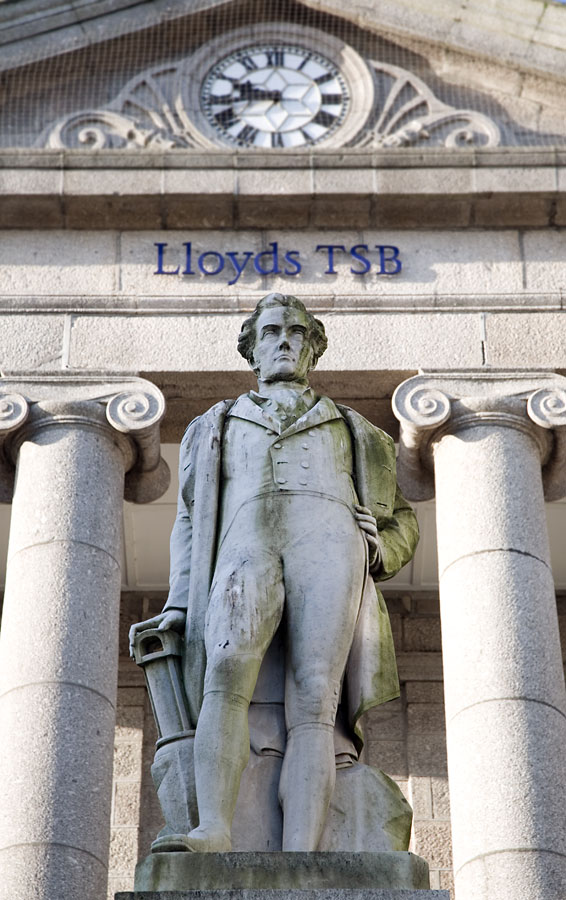A recent WI outing to Penzance (see right) brought to mind the same journey I did the year before, when I came down with a friend and, without calling into the pool, went for a walk around the town looking at some of the very old buildings and soaking up the history, exploring side streets and walkways. This walk is a good one to do when the weather is not so good.
From the harbour turn right up Market Jew Street, with its beautiful granite steps and old iron railings. At the top of the street is the impressive market house which today houses Lloyds Bank. Next to the bank is a statue of Sir Humphry Davy, the man famous for inventing the miners’ safety lamp, a huge step from the candles which could ignite flammable gases underground with devastating results. The previous prosperity of Penzance is evident at every turn although a good number of architecturally fine buildings are today in a very sorry state of repair.
Going down Chapel St there is an intriguing building on the right called the Egyptian House, it has the most ornate facade I have ever seen and is a Grade 1 listed building. It belonged to a mineralogist/bookseller who apparently bought two cottages and then set about creating what is seen today. It was purchased by the Landmark Trust in 1968 and fully restored, with the upper floors now possible to rent for holiday accommodation.
Working our way along side roads and back streets we came to the very pretty Regent Square. With its attractive houses and cottages, I am sure it must have been a most desirable place to live, being far enough away from the sounds and smells of the harbour area but close enough to the seafront. There is a sign on a wall which is easy to miss and will point you in the direction of Morrab Gardens, which is well worth a visit. The gardens are sub tropical and home to a large collection of exotic plants with a path that goes around in loops and gives the visitor the impression of the area being larger than it actually is. In the late 1800s the town bought the property and the gardens then became a public park with the old mansion house becoming the town library.
Returning to the sea front we turned right and walked along the promenade, which always makes me think of a famous painting entitled ‘The Rain It Raineth Every Day’, painted by Norman Garstin of the Newlyn School in 1889. It depicts a few people walking and taking the sea air along the promenade on a wet and windy day, with waves breaking over the sea wall, not unlike the scene of recent weeks. When we were there the weather was very pleasant and people were enjoying their day out.
The broad seafront goes right along to Newlyn and being so flat is an easy walk for most people and also very accessible for wheelchair users. Newlyn is a busy fishing port with numerous boats landing fish daily and ranked as one of the biggest fish markets left in the UK, with constant activity loading refrigerated lorries to enable distribution across the country. Of course, fish features on most restaurant menus and one of the best eating experiences I had was at an unassuming restaurant called Argoe at the end of the harbourside car park. It is basically a shack but serves the most wonderful fresh fish having being landed that day within metres of the kitchen. I had a spider crab and it was such sweet meat it was well worth the effort of getting it out of the legs and down to its toes.
In 1937 the authorities set about a slum clearance and a lot of cottages were demolished which provoked irate Newlyn folk to sail up the Thames in the fishing boat ‘Rosebud’ to the Houses of Parliament and overturn the decision which saved the remaining homes and gives Newlyn the character and charm we see today.
Carrying on along the road towards Mousehole we passed the old Penlee lifeboat station which now stands as a memorial to the crew of the lifeboat Solomon Browne which was lost with all hands in 1981 while going to assist the Union Star which had lost power and was drifting towards the cliffs. In total 16 men, eight lifeboat men and the eight crew on the Union Star, perished on that night, December 19, making it one of the worst lifeboat disasters of all time.
Erica Simpson


